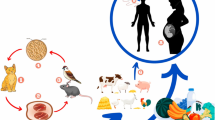Abstract
This study was designed to evaluate and compare the infection rate and cyst formation in male Balb/c mice following intraperitoneal injection of protoscoleces and activated oncospheres. Protoscoleces were collected aseptically from the liver of naturally infected sheep. The eggs were obtained from three experimentally infected dogs and activated oncospheres were prepared as described by Heath and Smyth (1970) and Kyngdon et al. (2006). A total of 20 Balb/c mice were divided into two groups of ten animals each. The mice of first and second groups were intraperitoneally infected with 1,500 protoescoleces and 1,500 activated oncosphere respectively. After 8 months of infection, all mice were euthanized, necropsied and the hydatid cysts were removed, counted, measured and weighed. The results showed that nine of ten mice of first group were infected. The maximum number of cysts was 551 in one mouse with mean size of 3.78 ± 2.21 mm and total weight of 25.48 g. The minimum number of cysts was 13 in one mouse with mean size of 3.93 ± 2.18 mm and total weight of 0.564 g. In the second group, only one mouse was infected with two cyst with mean size of 11.15 ± 1.94 mm and total weight of 1.193 g. This study showed that the male Balb/c inbred mouse is more permissive to infection with intraperitoneal injection of protoscoleces than activated oncospheres.

Similar content being viewed by others
References
Breijo M, Anesetti G, Martinez L, Sim RB, Ferreira AM (2008) Echinococcus granulosus: the establishment of the metacestode is associated with control of complement-mediated early inflammation. Exp Parasitol 118:188–196
Colli CW, Schantz PM (1974) Growth and development of Echinococcus granulosus from embryophores in an abnormal host (Mus musculus). J Parasitol 60:53–58
Conchedda M, Gabriele F, Bortoletti G (2004) Immunobiology of cystic echinococcosis. Parassitologia 46:375–380
Dempster RP, Berridge MV, Harrison GBL, Heath DD (1991) Echinococcus granulosus: development of an intermediate host mouse model for use in vaccination studies. Int J Parasitol 21:549–554
Heath DD, Lawrence SB (1996) Antigenic polypeptides of Echinococcus granulosus oncospheres and definition of protective molecules. Parasite Immunol 18:347–357
Heath DD, Smyth JD (1970) In vitro cultivation of Echinococcus granulosus, Taenia hydatigena, T. ovis, T.pisiformis and T. serialis from oncosphere to cystic larva. Parasitology 61:329–343
Kyngdon CT, Gauci CG, Rolfe RA, Velásquez Guzmán JC, Farfán Salazar MJ, Verástegui Pimentel MR, Gonzalez AE, Garcia HH, Gilman RH, Strugnell RA, Lightowlers MW (2006) In vitro oncosphere-killing assays to determine immunity to the larvae of Taenia pisiformis, Taenia ovis, Taenia saginata and Taenia solium. J Parasitol 92:273–281
McManus DP, Smyth JD (1986) Hydatid disease (hydatidosis): changing concepts in epidemiology and speciation. Parasitol Today 2:163–168
Moazeni M, Alipour-Chaharmahali MR (2011) Echinococcus granulosus: in vitro effectiveness of warm water on protoscolices. Exp Parasitol 127:14–17
Moro P, Schantz PM (2009) Echinococcosis: a review. Int J Infect Dis 13:125–133
Mourglia-Ettlin G, Marque JM, Chabalgoity JA, Dematteis S (2011) Early peritoneal immune response during Echinococcus granulosus establishment displays a biphasic behavior. PLoS Negl Trop Dis 5:1–11
Nakaya K, Mamuti W, Xiao N, Sato MO, Wandra T, Nakao M, Sako Y, Yamasaki H, Ishikawa Y, Craig PS, Schantz PM, Ito A (2006) Usefulness of severe combined immunodeficiency (scid) and inbred mice for studies of cysticercosis and echinococcosis. Parasitol Int 55:91–97
Rahimi HR, Sarkari B, Mohammadzadeh T, Sadjjadi SM (2011) Immune responses to antigens of in vitro reared Echinococcus granulosus adult worms in Balb/c mice. Iran J Immunol 8:236–243
Sharifiyazdi H, Oryan A, Ahmadnia S, Valinezhad A (2011) Genotypic characterization of Iranian camel (Camelus deromdarius) isolates of Echinoccocus granulosus. J Parasitol 97:251–255
Thompson RCA, Lymbery AJ (1995) Echinococcus and hydatid disease. In: Thompson RCA (ed) Biology and systematics of echinococcus, 1st edn. CAB International, Wallingford, pp 1–50
Walker M, Rossignol JF, Torgerson P, Hemphill A (2004) In vitro effects of nitazoxanide on Echinococcus granulosus protoscoleces and metacestodes. J Antimicrob Chemother 54:609–616
Zak O, Sande MA (1999) Hand book of animal models of infection. In: Romig T, Bilger B (eds) Animal models for echinococcosis, 1st edn. Academic press, San Diego, London, Boston, pp 877–884
Zhang W, You H, Zhang Z, Turson G, Hasyet A, McManus DP (2001) Further studies on an intermediate host murine model showing that primary Echinococcus granulosus infection is protective against subsequent oncospheral challenge. Parasitol Int 50:279–283
Zhang W, Ross AG, McManus DP (2008) Mechanisms of immunity in hydatid disease: implications for vaccine. J Immunol 181:6679–6685
Author information
Authors and Affiliations
Corresponding author
Rights and permissions
About this article
Cite this article
Ahmadnia, S., Moazeni, M., Mohammadi-Samani, S. et al. Hydatid cyst formation in male Balb/c mice following the intraperitoneal injection of live protoscoleces and activated oncospheres: a comparative study. J Parasit Dis 38, 77–80 (2014). https://doi.org/10.1007/s12639-012-0198-9
Received:
Accepted:
Published:
Issue Date:
DOI: https://doi.org/10.1007/s12639-012-0198-9




